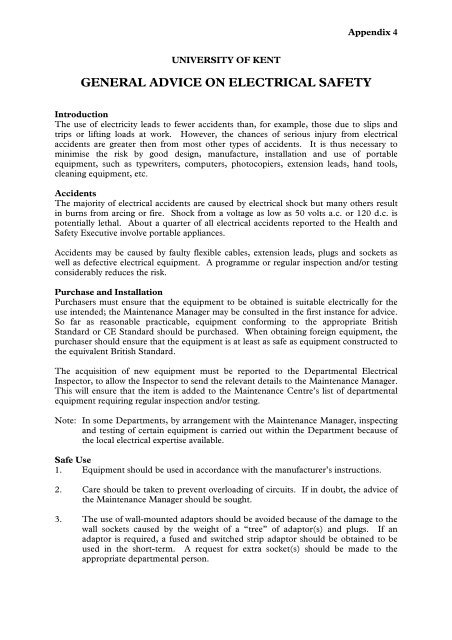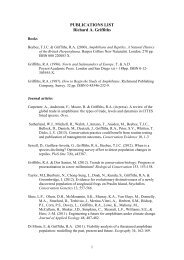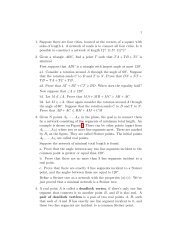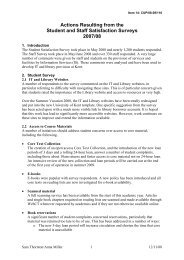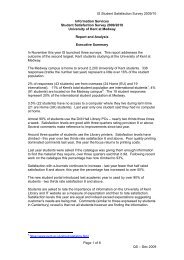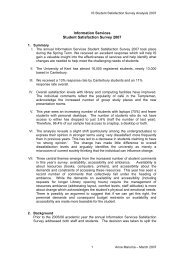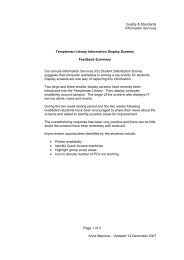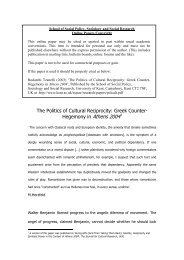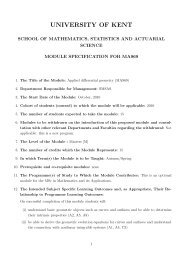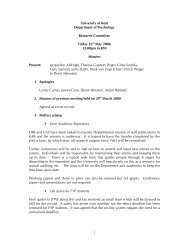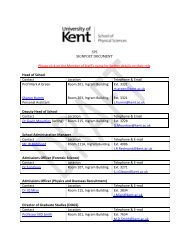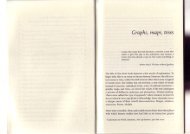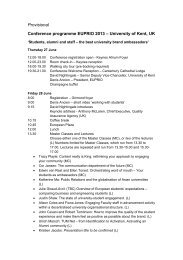Appendix 4 - General Advice on electrical safety - University of Kent
Appendix 4 - General Advice on electrical safety - University of Kent
Appendix 4 - General Advice on electrical safety - University of Kent
You also want an ePaper? Increase the reach of your titles
YUMPU automatically turns print PDFs into web optimized ePapers that Google loves.
<str<strong>on</strong>g>Appendix</str<strong>on</strong>g> 4<br />
UNIVERSITY OF KENT<br />
GENERAL ADVICE ON ELECTRICAL SAFETY<br />
Introducti<strong>on</strong><br />
The use <strong>of</strong> electricity leads to fewer accidents than, for example, those due to slips and<br />
trips or lifting loads at work. However, the chances <strong>of</strong> serious injury from <strong>electrical</strong><br />
accidents are greater then from most other types <strong>of</strong> accidents. It is thus necessary to<br />
minimise the risk by good design, manufacture, installati<strong>on</strong> and use <strong>of</strong> portable<br />
equipment, such as typewriters, computers, photocopiers, extensi<strong>on</strong> leads, hand tools,<br />
cleaning equipment, etc.<br />
Accidents<br />
The majority <strong>of</strong> <strong>electrical</strong> accidents are caused by <strong>electrical</strong> shock but many others result<br />
in burns from arcing or fire. Shock from a voltage as low as 50 volts a.c. or 120 d.c. is<br />
potentially lethal. About a quarter <strong>of</strong> all <strong>electrical</strong> accidents reported to the Health and<br />
Safety Executive involve portable appliances.<br />
Accidents may be caused by faulty flexible cables, extensi<strong>on</strong> leads, plugs and sockets as<br />
well as defective <strong>electrical</strong> equipment. A programme or regular inspecti<strong>on</strong> and/or testing<br />
c<strong>on</strong>siderably reduces the risk.<br />
Purchase and Installati<strong>on</strong><br />
Purchasers must ensure that the equipment to be obtained is suitable <strong>electrical</strong>ly for the<br />
use intended; the Maintenance Manager may be c<strong>on</strong>sulted in the first instance for advice.<br />
So far as reas<strong>on</strong>able practicable, equipment c<strong>on</strong>forming to the appropriate British<br />
Standard or CE Standard should be purchased. When obtaining foreign equipment, the<br />
purchaser should ensure that the equipment is at least as safe as equipment c<strong>on</strong>structed to<br />
the equivalent British Standard.<br />
The acquisiti<strong>on</strong> <strong>of</strong> new equipment must be reported to the Departmental Electrical<br />
Inspector, to allow the Inspector to send the relevant details to the Maintenance Manager.<br />
This will ensure that the item is added to the Maintenance Centre’s list <strong>of</strong> departmental<br />
equipment requiring regular inspecti<strong>on</strong> and/or testing.<br />
Note: In some Departments, by arrangement with the Maintenance Manager, inspecting<br />
and testing <strong>of</strong> certain equipment is carried out within the Department because <strong>of</strong><br />
the local <strong>electrical</strong> expertise available.<br />
Safe Use<br />
1. Equipment should be used in accordance with the manufacturer’s instructi<strong>on</strong>s.<br />
2. Care should be taken to prevent overloading <strong>of</strong> circuits. If in doubt, the advice <strong>of</strong><br />
the Maintenance Manager should be sought.<br />
3. The use <strong>of</strong> wall-mounted adaptors should be avoided because <strong>of</strong> the damage to the<br />
wall sockets caused by the weight <strong>of</strong> a “tree” <strong>of</strong> adaptor(s) and plugs. If an<br />
adaptor is required, a fused and switched strip adaptor should be obtained to be<br />
used in the short-term. A request for extra socket(s) should be made to the<br />
appropriate departmental pers<strong>on</strong>.
4. Care should be taken to prevent trailing cables from becoming a hazard; they<br />
should be tucked away or lifted above walk-ways but, if a cable lying across a walkway<br />
is unavoidable, the trip hazard should be reduced by the use <strong>of</strong> a cable cover.<br />
5. Care should be taken to avoid obstructing any air grill or fan outlet <strong>on</strong> equipment.<br />
6. Users <strong>of</strong> hand-held equipment should take particular care to avoid damaging the<br />
cable and to avoid putting stress <strong>on</strong> the c<strong>on</strong>necti<strong>on</strong>s by overstretching the cable.<br />
7. Apart from equipment designed to be left <strong>on</strong> permanently, all equipment should<br />
be switched <strong>of</strong>f at the appliance itself and at the wall socket at the end <strong>of</strong> the<br />
working day.<br />
Inspecti<strong>on</strong>s and tests<br />
1. A regular programme <strong>of</strong> formal visual inspecti<strong>on</strong>s and, where necessary, testing has<br />
been set up; this shared between the Department Electrical Inspector(s) and the<br />
Maintenance staff. Each Inspector carries out inspecti<strong>on</strong>s at appropriate intervals<br />
using a check list provided by the Maintenance Manager; the inspecti<strong>on</strong> interval<br />
depends up<strong>on</strong> the equipment and is not necessarily <strong>on</strong>e year.<br />
Each piece <strong>of</strong> equipment logged with the Maintenance Centre is identified by a<br />
number <strong>of</strong> barcode label and, after testing, will be fitted with a label bearing the<br />
legend<br />
“Tested for <strong>electrical</strong> <strong>safety</strong><br />
Re-test due<br />
(date)<br />
(date)”<br />
Out <strong>of</strong> date equipment must not be used until it has been re-tested.<br />
2. In between the formal visual inspecti<strong>on</strong>s users should regularly examine their<br />
equipment for signs <strong>of</strong> damage or deteriorati<strong>on</strong>, both <strong>on</strong> the appliance itself and <strong>on</strong><br />
the cable and plug. Checks should be made for faults such as badly-damaged<br />
casing <strong>of</strong> the appliance or plug, the cable sheath worn or torn and loose<br />
c<strong>on</strong>necti<strong>on</strong>s into the plug or appliance.<br />
3. The frequency <strong>of</strong> the visual check by the user depends <strong>on</strong> the type <strong>of</strong> equipment<br />
and how it is used but, as a rough guide, equipment rarely moved or unplugged<br />
such as computers and typewriters should be checked m<strong>on</strong>thly and hand-held<br />
tools such as drills and chain-saws should be checked each time they are used.<br />
Faults<br />
1. Repairs must <strong>on</strong>ly be undertaken by a competent pers<strong>on</strong> e.g. an electrician or a<br />
trained technician.<br />
2. Users finding faulty or broken equipment should take it out <strong>of</strong> use immediately,<br />
label it “Defective – do not use” and initiate repairs according to the local rules.<br />
Safety Office<br />
Jan 1992<br />
Amended Feb 1999


